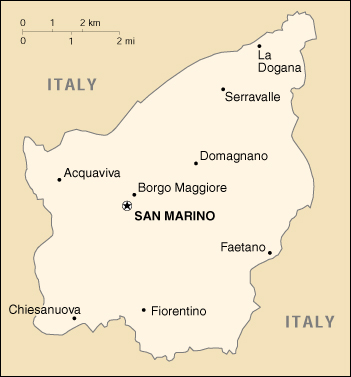Facts About San Marino
Background: The third smallest state in Europe (after the Holy See and Monaco) also claims to be the world’s oldest republic. According to tradition, it was founded by a Christian stonemason named Marinus in 301 A.D. San Marino’s foreign policy is aligned with that of Italy. Social and political trends in the republic also track closely with those of its larger neighbor.
Government type: republic
Capital: San Marino
Currency: euro (EUR)
Geography of San Marino
Location: Southern Europe, an enclave in central Italy
Geographic coordinates: 43 46 N, 12 25 E
Area:
total: 60.5 sq km
land: 60.5 sq km
water: 0 sq km
Land boundaries:
total: 39 km
border countries: Italy 39 km
Coastline: 0 km (landlocked)
Climate: Mediterranean; mild to cool winters; warm, sunny summers
Terrain: rugged mountains
Elevation extremes:
lowest point: Torrente Ausa 55 m
highest point: Monte Titano 749 m
Natural resources: building stone
Land use:
arable land: 17%
permanent crops: 0%
permanent pastures: 0%
forests and woodland: 0%
other: 83% (1993 est.)
Environment – international agreements:
party to: Biodiversity, Climate Change, Desertification, Nuclear Test Ban
signed, but not ratified: Air Pollution
Geography – note: landlocked; smallest independent state in Europe after the Holy See and Monaco; dominated by the Apennines
People of San Marino
San Marino is comprised of native Sammarinese and Italian citizens. Crop farming, sheep farming and the working of stone from the quarries formed the early backbone of San Marino’s economy.
Population: 28,880 (July 2005 est.)
Age structure:
0-14 years: 15.88%
15-64 years: 67.94%
65 years and over: 16.18%
Population growth rate: 1.45%
Birth rate: 10.76 births/1,000 population
Death rate: 7.68 deaths/1,000 population
Net migration rate: 11.45 migrant(s)/1,000 population
Infant mortality rate: 6.21 deaths/1,000 live births
Life expectancy at birth:
total population: 81.23 years
male: 77.68 years
female: 85.1 years
Total fertility rate: 1.3 children born/woman
Nationality:
noun: Sammarinese (singular and plural)
adjective: Sammarinese
Ethnic groups: Sammarinese, Italian
Religions: Roman Catholic
Languages: Italian
Literacy:
definition: age 10 and over can read and write
total population: 96%
male: 97%
female: 95% (1976 est.)
History of San Marino
According to tradition, San Marino was founded in AD 301 when a Christian stonemason named Marinus the Dalmation fled the island of Arbe to escape the anti-Christian Roman Emperor Diocletian. Marinus hid on the peak of Mount Titano and founded a small community of people following their Christian beliefs. It is certain that the area had been inhabited since prehistoric times, although evidence of existence on Mount Titano dates back only to the Middle Ages. In memory of the stone cutter, the land was renamed “Land of San Marino,” then called the “Community of San Marino,” and was finally changed to its present-day name, “Republic of San Marino.”
The original government structure was composed of a self-governed assembly known as the Arengo, which consisted of the heads of each family. In 1243, the positions of Captains Regent (Capitani Reggenti) were established to be the joint heads of state.
The land area of San Marino consisted only of Mount Titano until 1463, when the republic entered into an alliance against Sigismondo Pandolfo Malatesta, Lord of Rimini, who was later defeated. As a result, Pope Pius II Piccolomini gave San Marino the towns of Fiorentino, Montegiardino, and Serravalle. Later that year, the town of Faetano joined the republic on its own accord. Since then, the size of the country has remained the same.
San Marino has been occupied by foreign militaries twice in its history, both for only short periods of time. In 1503 Cesare Borgia, known as Valentino, occupied the republic until his death several months later. In 1739, Cardinal Alberoni used military force to occupy the country, but civil disobedience was used to protest this, and clandestine notes sent to the Pope to obtain justice were answered by the Pope’s recognition of San Marino’s rights and restoration of independence.
San Marino Economy
Economy – overview: The tourist sector contributes over 50% of GDP. In 1999 more than 3 million tourists visited San Marino. The key industries are banking, wearing apparel, electronics, and ceramics. Main agricultural products are wine and cheeses. The per capita level of output and standard of living are comparable to those of the most prosperous regions of Italy, which supplies much of its food.
GDP: purchasing power parity – $860 million (2000 est.)
GDP – real growth rate: 8% (2000 est.)
GDP – per capita: purchasing power parity – $32,000 (2000 est.)
Inflation rate (consumer prices): 2.2% (2000)
Labor force: 18,500 (1999)
Labor force – by occupation: services 60%, industry 38%, agriculture 2% (1998 est.)
Unemployment rate: 3% (1999)
Budget:
revenues: $400 million
expenditures: $400 million (2000 est.)
Industries: tourism, banking, textiles, electronics, ceramics, cement, wine
Industrial production growth rate: 6% (1997 est.)
Electricity – production: electric power supplied by Italy (1999)
Agriculture – products: wheat, grapes, corn, olives; cattle, pigs, horses, beef, cheese, hides
Exports: trade data are included with the statistics for Italy
Exports – commodities: building stone, lime, wood, chestnuts, wheat, wine, baked goods, hides, ceramics
Imports: trade data are included with the statistics for Italy
Imports – commodities: wide variety of consumer manufactures, food
Currency: euro (EUR)
Map of San Marino
